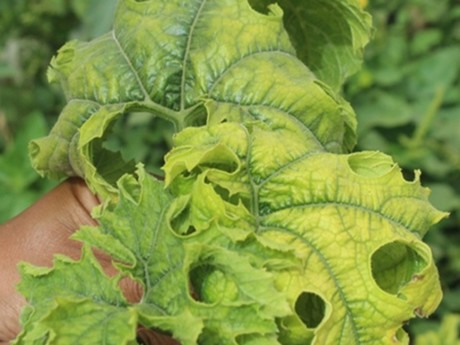Over the last couple of years the New Delhi virus (ToLCNDV) has caused serious problems for growers in Italy, Spain and Tunisia and several Asian countries. In Sicily it devastated courgette campaigns, in Almeria it delayed harvests severely and severe infections of tomato were observed in heated plastic tunnels in the South of Tunisia.
EPPO now confirms that symptoms resembling those caused by Tomato leaf curl New Delhi virus (Begomovirus, ToLCNDV EPPO Alert List) were observed in zucchini (Cucurbita pepo) crops growing near Agadir and Taroudant in Morocco in 2017. "The incidence of disease was significant, with severe yellow mosaic symptoms accompanied by leaf curling and roughness of the fruit skin (Fig. 1). The infected plants had smaller and fewer fruits when compared to healthy ones and in most cases fruit bursting was observed", reads the report by BSPP.
Leaf samples were collected from diseased zucchini plants (9 samples taken near Agadir and 6 taken near Taroudant) and tested by molecular tests (PCR tests with generic and specific primers). Results confirmed the presence of ToLCNDV in all 9 samples from Agadir and in 4 out of 6 samples from Taroudant. This is the first time that ToLCNDV is reported from Morocco.

ToLCNDV
ToLCNDV is transmitted by Bemisia tabaci in a persistent mode. Initially the virus was found on tomato, then other Solanaceae as aubergine, peppers and potato. ToLCNDV can also infect cucurbitaceae including wax gourd, (water)melon, cucumbers, pumpkins, courgettes etc. In Spain, the virus was detected in melon (Cucurbita melo, C. melo var. flexuosus), pumpkin (C. pepo) and cucumber (Cucumis sativus) crops, but apparently not in tomato. In Tunisia, ToLCNDV was also found only in cucurbit crops. ToLCNDV is on the EPPO Alert List.
It is not known if the virus can be transmitted by contact or by seeds. "The biggest problem when managing this virus is the fact that the fly infects plants throughout its life cycle and passes on the virus to its progeny, thus becoming an unstoppable vector", we explained earlier. Control measures against ToLCNDV are very limited and mainly rely on whitefly control, cultivation under insect-proof greenhouses, elimination of infected plants, and avoidance of the most susceptible cultivars.
ToLCNDV in Morocco
In many Mediterranean countries, including Morocco, the environmental conditions are favourable for cucurbit crops and therefore such crops are of economic significance. In Morocco, the surface seeded with vegetable crops, which included cucurbit crops, increased to 260,000 ha in 2011 with an annual production of 7 million tonnes of which 750,000 tonnes were for export. Unfortunately, over the past four years, cucurbit production has been reduced in many countries by infection with the bipartite begomovirus Tomato leaf curl New Delhi virus (ToLCNDV).










